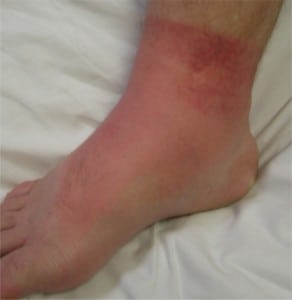| Author | Affiliation |
|---|---|
| Christopher C. Trigger, MD | University of Illinois at Chicago, Department of Emergency Medicine |
| Wesley Eilbert, MD | University of Illinois at Chicago, Department of Emergency Medicine |
A previously healthy 31-year-old man presented to the emergency department complaining of right foot pain and a non-pruritic rash with swelling for one day. He reported spilling jet fuel on his right lower leg at work the previous evening and had worn the fuel-soaked sock for another 10 hours. Physical examination demonstrated a coalescing erythematous macular rash with mild non-pitting edema in a sock-like pattern extending from the ankle inferiorly across the dorsum of the foot (Figure 1.) The affected skin was warm to touch compared to the unaffected foot.

Irritant contact dermatitis is a nonspecific inflammation of the skin caused by the release of mediators of inflammation in response to chemical damage.1 Some animal studies have shown that the release of chemokines and cytokines, both markers of inflammation, causes erythema, edema and hyperplasia of the skin when it is exposed to Jet propulsion fuel 8 (JP-8), but this exact mechanism is not completely understood.2, 3 Irritant contact dermatitis is not a true pruritic allergic reaction, distinguishing it from allergic contact dermatitis. Irritant dermatitis can be caused by a wide variety of compounds including surfactants, solvents, oils, and hydrocarbons.2, 4 JP-8 is a complex mixture of hydrocarbons used as a multipurpose fuel for commercial aircraft, as well as ground vehicles, generators, heaters and stoves. JP-8 and other kerosene-based fuels have been shown to cause skin irritation, skin sensitization and even skin tumors with repeated or prolonged contact.2
Treatment primarily involves removal of the offending agent by washing with a gentle soap and water. Topical corticosteroids have not been proven beneficial.4 Oral antihistamines may be useful for treatment of any associated pruritis.
Footnotes
Supervising Section Editor: Rick A McPheeters, DO
Submission history: Submitted August 12, 2008; Revision Received September 28, 2008; Accepted October 24, 2008
Full text available through open access at http://escholarship.org/uc/uciem_westjem
Address for Correspondence: Christopher Trigger, MD, Department of Emergency Medicine, University of Illinois at Chicago, 808 S. Wood Street CME 471, Chicago, IL 60612
Email: ctrigg1@uic.edu
Conflicts of Interest: By the WestJEM article submission agreement, all authors are required to disclose all affiliations, funding sources, and financial or management relationships that could be perceived as potential sources of bias. The authors disclosed none.
REFERENCES
1. Fyhrquist-Vanni N, Alenius H, Lauerma A. Contact dermatitis. Dermatol Clin.2007;25:613–623. [PubMed]
2. McDougal JN, Rogers JV. Local and systemic toxicity of JP-8 from cutaneous exposures.Toxicol Lett. 2004;149:301–8. [PubMed]
3. McDougal JN, Pollard DL, Weisman W, et al. Assessment of skin absorption and penetration of JP-8 jet fuel and its components. Toxicol Sci. 2000;55:247–255. [PubMed]
4. Hogan DJ. Contact dermatitis, irritantAvailable at:http://www.emedicine.com/derm/topics85.htm Accessed March 20, 2008.


